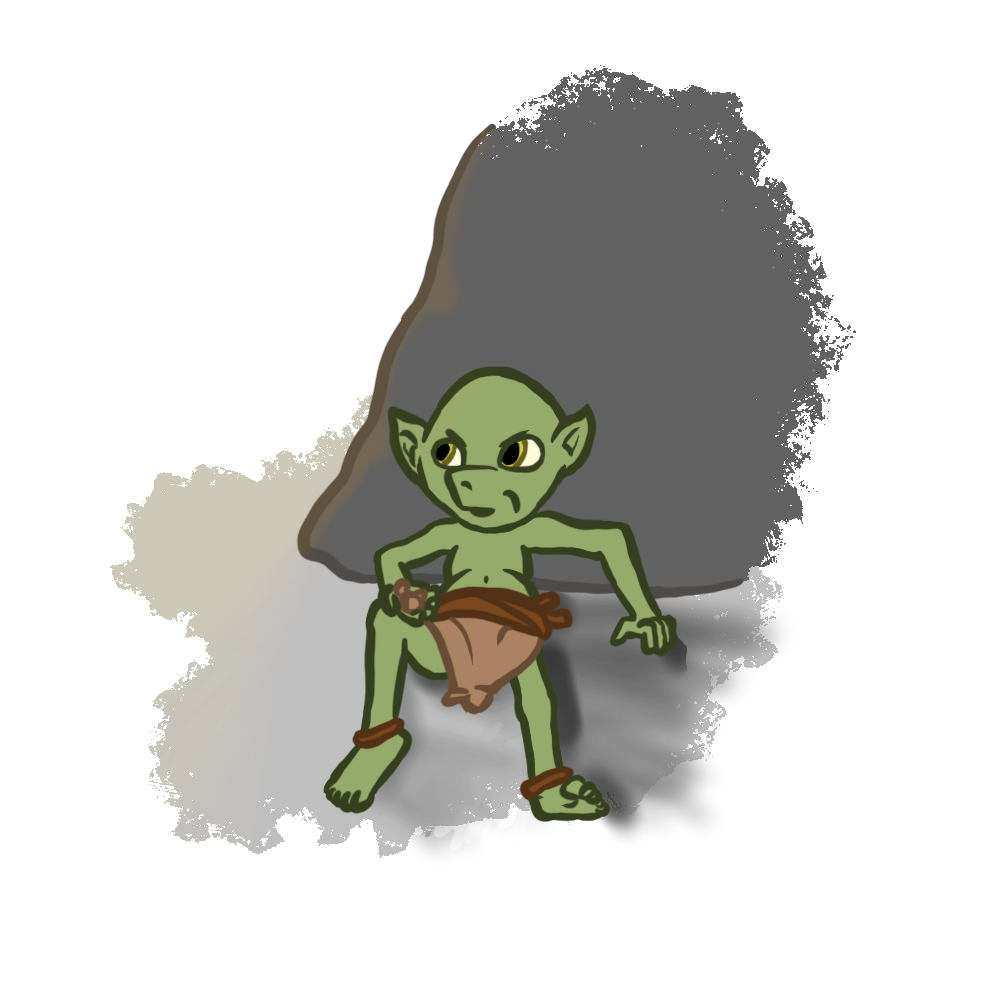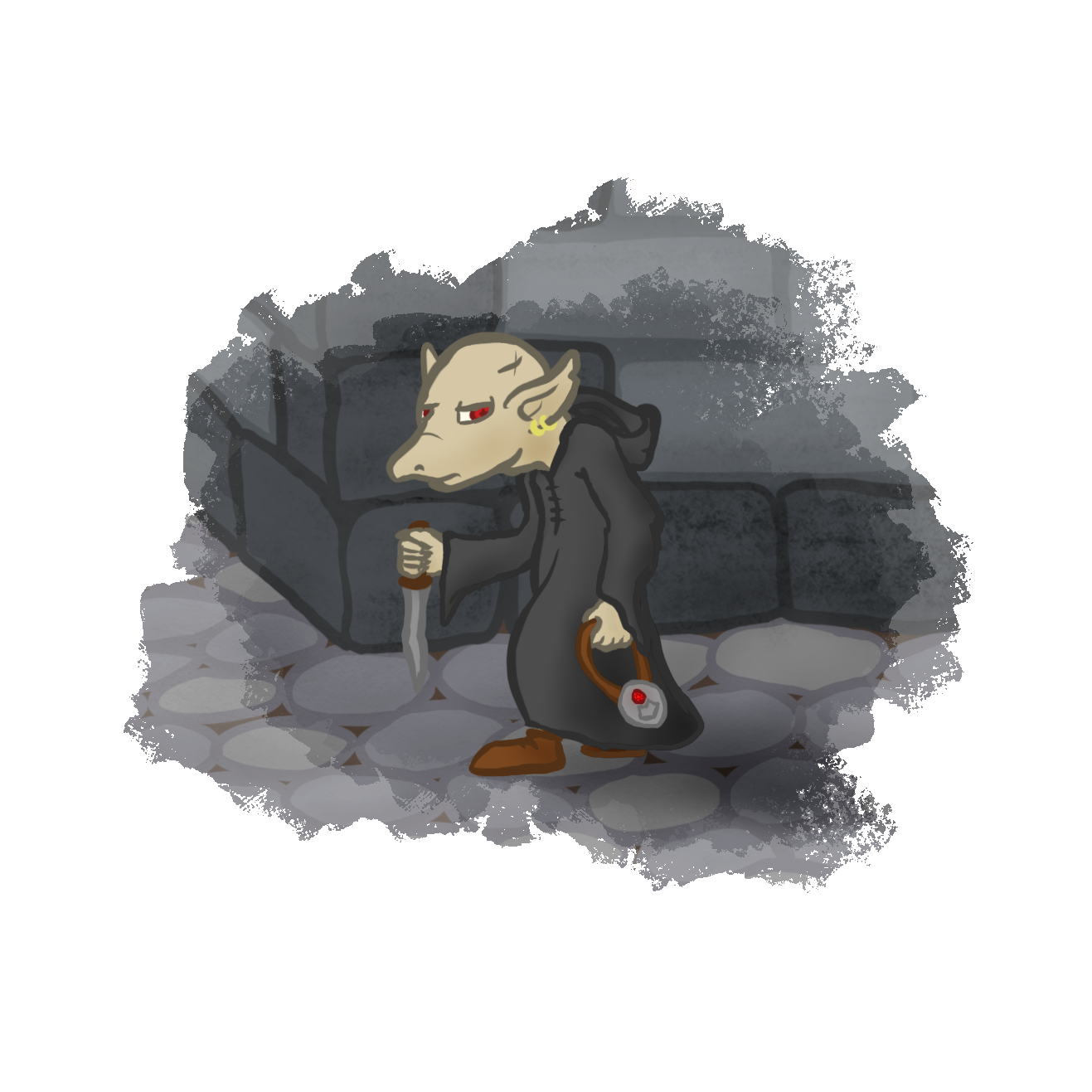Goblin
Goblins are bitter, vindictive, devious creatures. An empathetic goblin is a genetic failure; they are rare, and unlikely to survive in the backstabbing world of goblin society.
Underground Colonies

Common goblin civilization comprises thousands of small tribes scattered just underground and massive colonies in the larger caverns below. Only two things unite them: hatred for surface dwellers and fear of the more powerful denizens of the caves.
The extent of goblin infrastructure is short connecting tunnels between natural caverns. Few tunnels actually connect to where they were intended. More often, they dead-end due to lost motivation, going in the wrong direction, or—if so much as a single gemstone is unearthed—the entire mining team self-destructs in a frenzy of murders. Fortunately, goblins always find a use for empty tunnels.
Thousands of goblins in a small space would make for an unholy amount of filth if not for the wormpits. Gorv (likely a shortened form of the words for "shit worm") worms flourish in designated waste pits and can reach gargantuan sizes if left unchecked. Many fungi also grow in the wormpits. The most important variety, ukugogli (suspiciously reminiscent of the words for "tasty shit mushroom"), is a staple in goblin cuisine. The other staple is fried gorv.
Shadowed Citadels

Dark goblins are fewer in number but more organized. They live in some of the deepest tunnels of Gabroria. They show some measure of skill in masonry and carve out proper cities, even if the angles aren't quite aligned. They worship Amnat, a god of darkness and vengeance, in a religion called Mrakism. Common goblins fear them.
Predatory Abominations
Rarest of all, ungoblins are solitary hunters, and have no culture of their own. Most ungoblins do not even speak a language. They stalk shallow caves in western Gabroria. Ungoblins are feared by all races for their hunting tactic: they lie in wait in a cave just below the surface with an entrance nearby. When a creature gets close enough, the ungoblin unleashes a psychic attack to either kill or stun the victim. Once its prey is neutralized, the ungoblin emerges from its hiding place and finishes the job.
<redacted> Physical Appearances
Common goblins are short, bony, greasy things with sickly green skin of any shade. Malnutrition often gives them distended bellies and other deformities.
Dark goblins are similar in build but with white, slightly translucent skin and huge eyes. They stay partially cloaked in tendrils of shadow whenever possible.
Ungoblins are twisted even by goblin reckoning. They have empty sockets for eyes, soft and bendable bones, and fingers that are twice as long as they ought to be. Extra fingers, limbs, and even heads afflict one ungoblin in three.
Game Mechanics
Abilities
Disease-Ridden. Goblin dens and cities are known for being filthy. Goblins suffer for it, having a low average Strength and Constitution score.
Survival by Cunning. Goblin society can be cutthroat. The slow and stupid are taken advantage of and don't last long. The survivors tend to be those with high Dexterity or Intelligence.
Alignment
Most goblin societies encourage shenanigans, bastardry, and deviousness. Good goblins don't last long in the underdark without likeminded friends.
Age
Goblins are short-lived creatures, reaching maturity at age 7. Your old age threshold is 30 years, and your aging rate is 2 years.
Speed
Despite your small size, your base walking speed is 30 feet.
Goblin
Size
MediumSpeeds
Walk 30 ft.Old Age Threshold
30 yearsLanguages
VariesSenses
—Aging Rate
2 yearsTraits
Nimble Escape. You can take the Disengage or Hide action as a minor action on each of your turns.
Subraces
Select one of the subraces below.
Common Goblin
Language. You are proficient in your clan's dialect of Goblish.
Darkvision. You have darkvision (60 ft.).
Resilient to Disease. You have advantage on saving throws against becoming diseased, and being diseased doesn't cause you to have disadvantage on Constitution saving throws.
Fury of the Small. When you damage a creature with an attack or a spell and the creature's size is larger than yours, you can cause the attack or spell to deal extra damage to the creature. The extra damage equals your proficiency bonus.
You can use this trait a number of times equal to your proficiency bonus, regaining all expended uses when you finish a short or long rest. You can use this trait no more than once per turn.
Dark Goblin
Language. You are proficient in Dark Goblish.
Superior Darkvision. You have darkvision (120 ft.).
Sunlight Sensitivity. You have disadvantage on attack rolls and on Perception checks that rely on sight when you, the target of your attack, or whatever you are trying to perceive is in direct sunlight.
Inured to Horrors. You have advantage on saving throws against being frightened.
Ungoblin
Aberrant Body. Your creature type is Humanoid, but you also register as an Aberration to abilities that detect aberrations.
Eyeless. You are have no sense of sight, as you lack eyes. You have blindsight (10 ft.).
Bendable Bones. Your bones are malleable. You can squeeze through a space as narrow as 2 inches wide.
Long Fingers. You have a climb speed of 20 feet.
Touch of Minds. You have mindsense (60 ft.). This mindsense can detect creatures with a Intelligence of -6 or higher, even ones that lack a language.
Additionally, you can communicate telepathically with any creature within 60 feet of you that you can see (by sensing its mind, for instance). You can transmit and receive words, images, sounds, and other sensory messages, allowing communication whether or not you share a common language. You can speak telepathically in this way to only one creature at a time.
Insidious Assault. You know the mind sliver cantrip and can cast it without components. Your spellcasting ability score for the spell is Intelligence. When you target a creature with this spell that's still affected by the last time you cast this spell against that creature, the target is dazed until the end of your next turn in addition to the spell's usual effects on a failed save.
Suggested Backgrounds
Goblintown Urchin
Prerequisite: The ability to speak Goblish; Small size or smaller
You grew up in a goblin colony or similar cesspool. You gain the following benefits:
- You are proficient in two of the following skills of your choice: Deception, Sleight of Hand, Stealth, or Survival.
- When you take the Disengage action, you can also attempt to escape from the grappled condition or any other effect causing your speed to be 0, provided that the effect permits you to attempt to escape as a standard action.
- When you take the Disengage action, you can move through the space of a creature that is your size or larger until the end of your turn.
- Other creatures that are your size or larger do not count as difficult terrain to you.
Servant of Amnat
Prerequisite: The ability to speak Dark Goblish; darkvision with a range of at least 60 feet
You are a devout servant of Amnat, dark goblin god of darkness and vengeance. You gain the following benefits:
- You learn each of the following spells once you have a spell slot capable of casting it: cause fear, darkness, fear, cloak of shadow, and commune.
- You can see normally in darkness, both magical and nonmagical, to a distance of 120 feet.
Feral Upbringing
You were raised by wolves–or at the very least, not by anything that talked. You gain the following drawback and benefits:
- You do not have the Language(s) trait of your race, if it has one. You may still choose to know the common language of the party.
- You are proficient in three of the following skills of your choice: Acrobatics, Animal Handling, Athletics, Intimidation, Nature, Perception, Stealth, and Survival.
- You have advantage on saving throws against being charmed.
Suggested Feats
prerequisite
Goblin (dark) or Servant of Amnat background
Amnat has blessed you with special powers of shadows and of revenge. You gain the following benefits:
- When you use the Attack action to make a melee weapon attack while in darkness, you can magically target a creature that you can see even if it is outside your reach. The creature must also be in darkness, and must be within 30 feet of you. The creature doesn't benefit from cover against this attack.
- When you reduce an enemy to 0 hit points while you are in darkness, you magically gain temporary hit points equal to your level. These temporary hit points vanish early if you are exposed to bright light.